To Tromso with Florian
Wrecked after our race to Skervøy, we deserved to sleep in. We did! The morning was rainy, so we had a slow breakfast in the tent vestibule, chatted with our hosts in Tromsø, and did some route-planning. We would stay in Sietske’s home, though she would mostly be away, and her roommate Ira would be there to let us in.
Hot lunch
First, though, it was time for hot lunch! We refilled the water filter, and H went off on a science tangent about the high D.O.C. (Dissolved Organic Carbon) content in the meltwater.

I have to admit it was beyond my weary mind, so my takeaway was basically that the water looked like tea and tasted just fine.
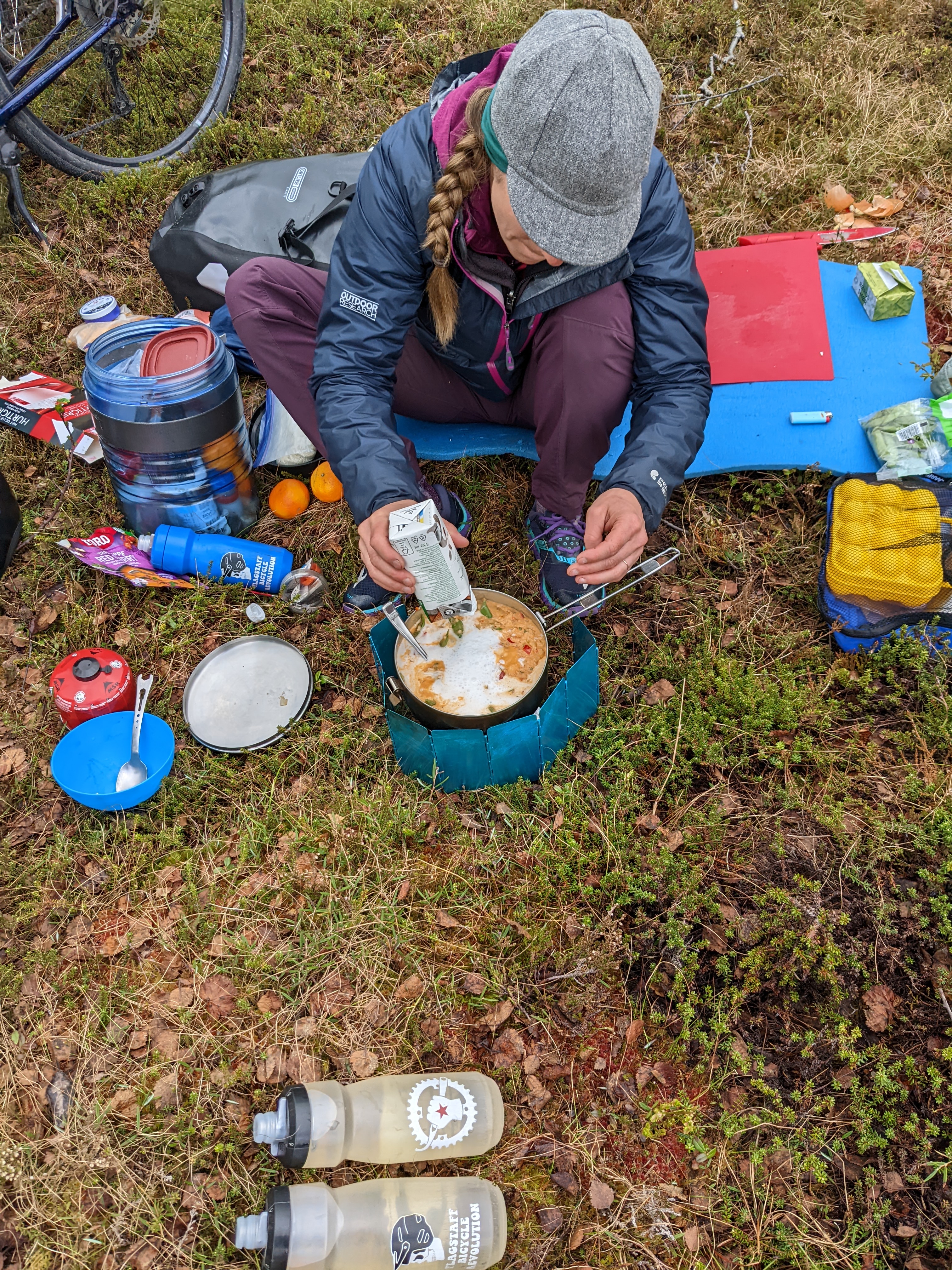
The Thai curry rice we made really hit the spot. Peas and peppers and coconut milk: real vegetables and fat that wasn’t butter! We took our sweet time packing up, and didn’t get down the hill to the bridge off of Skervøy until around 4PM.
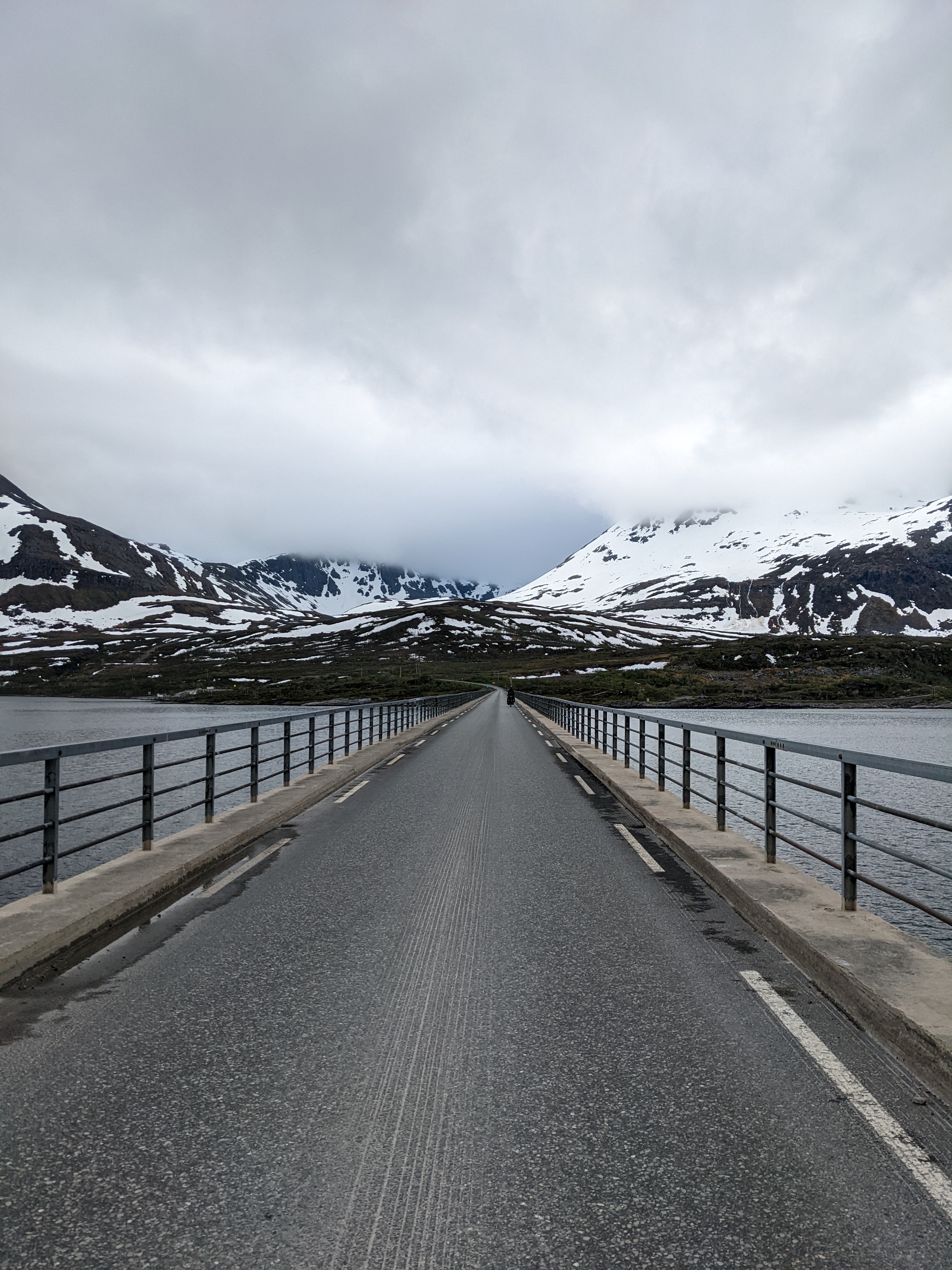
Sea tunnels
After Alta, I felt like a pro at tunnels - you just pop into a mountain, then pop out the other side sweating or shivering. Often, they’re built on a grade, and somehow that grade usually takes us downhill fast. Sea tunnels, though? Whole new thing.
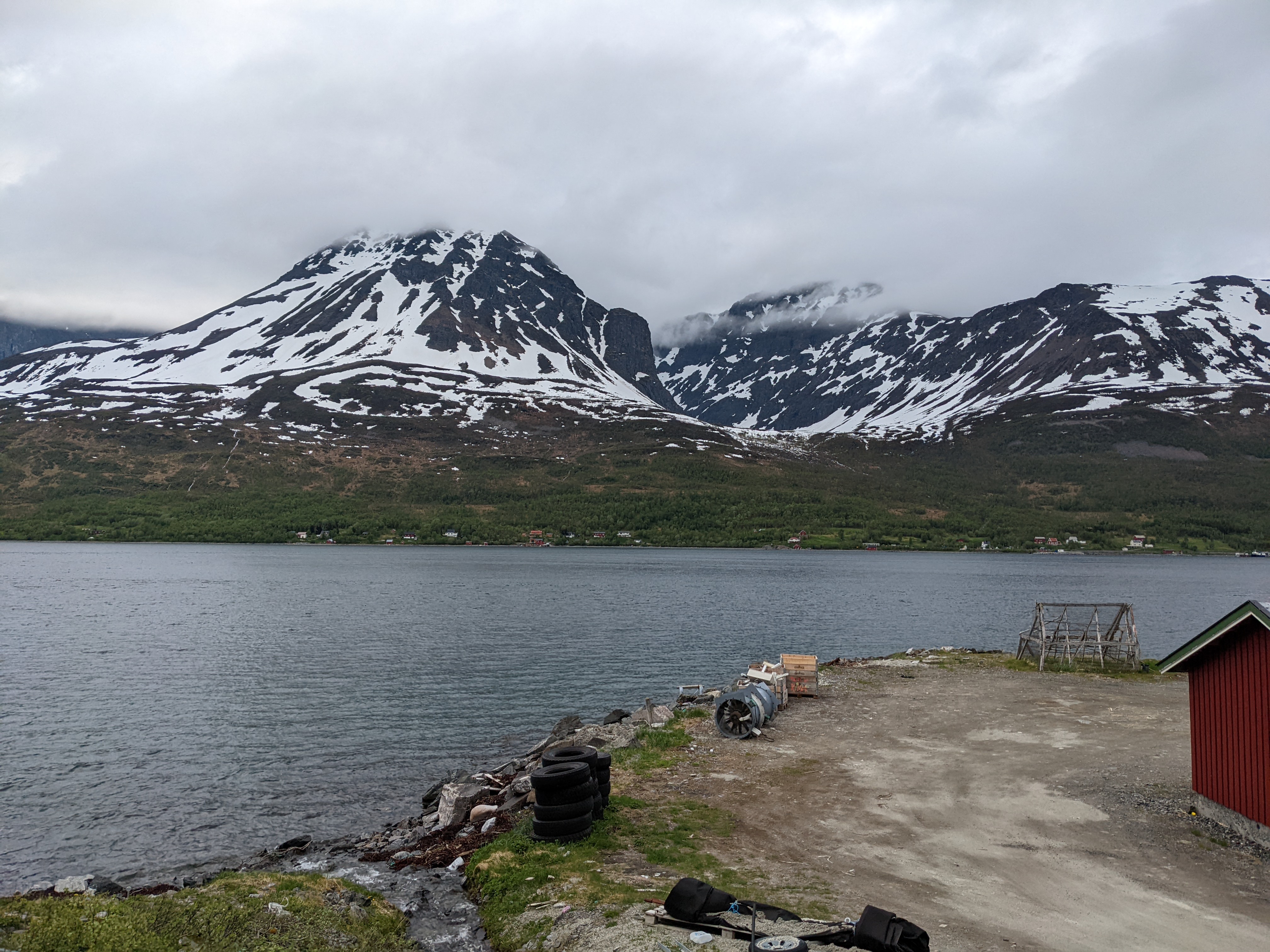
Maursund tunnelen crosses this stretch of water, dropping to almost 100 meters below sea level at a screaming pace, and climbing back to the surface at a similarly steep 8 or 9% grade. It’s only 2.2 km long, but there’s something about riding a bicycle up out of the sea that’s unsettling. There are huge fans in the tunnel to help keep the air quality safe. They’re louder than a semi-truck in a stone tube, and the draft that hits you while you’re hurtling downhill looking over your shoulder for headlights is so strong it can throw you off course. I can’t imagine many solo bike accident scenarios scarier than a 35 mph wreck at the bottom of a tunnel, so ride these with caution.
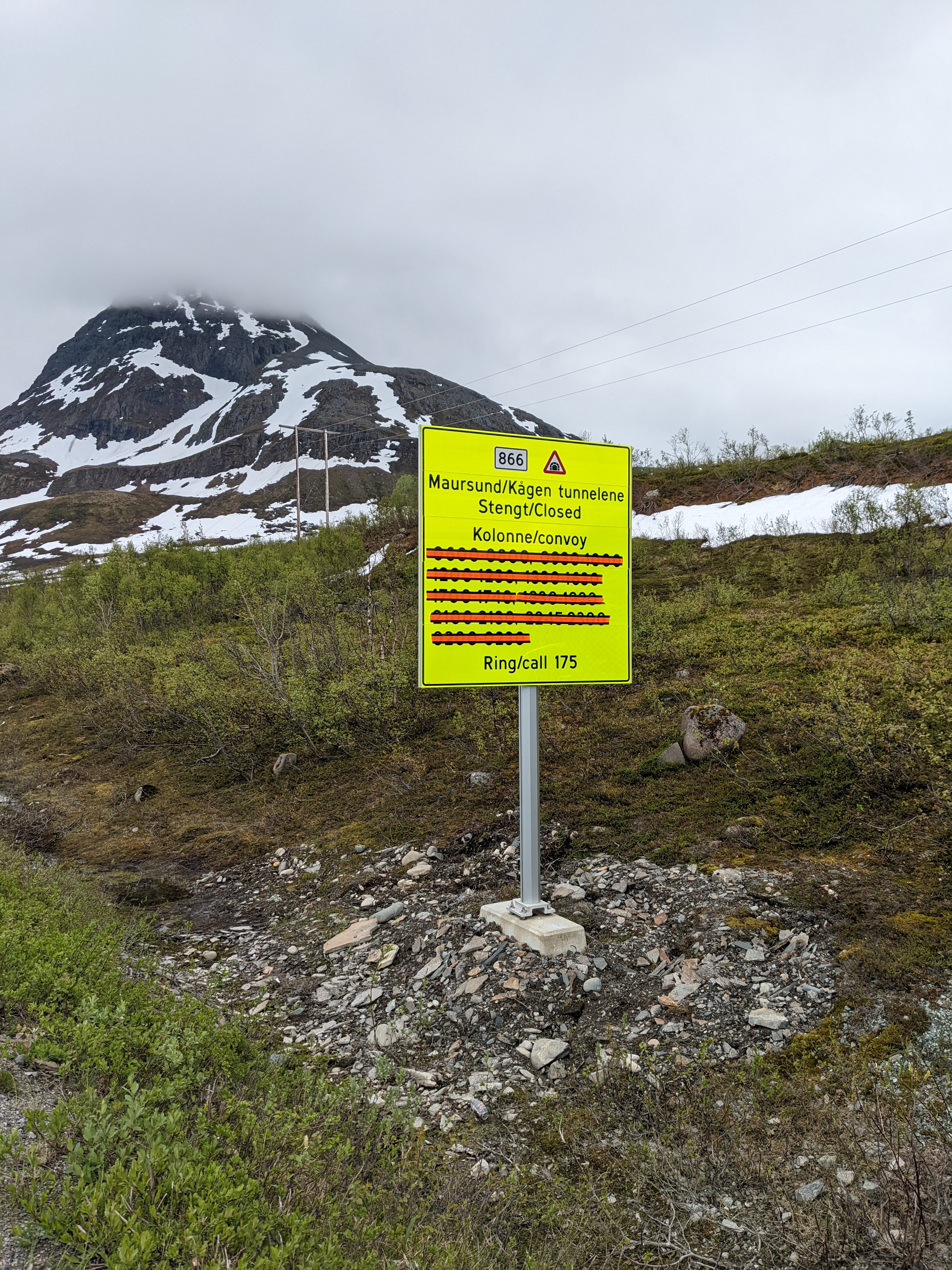
After a moment of panic that we might have come this far only to find the tunnel to the mainland closed, a quick call to 175 taught us that the “tunnel closed” sign actually meant the tunnel was open. Our crafty bridge bypass was going to succeed!
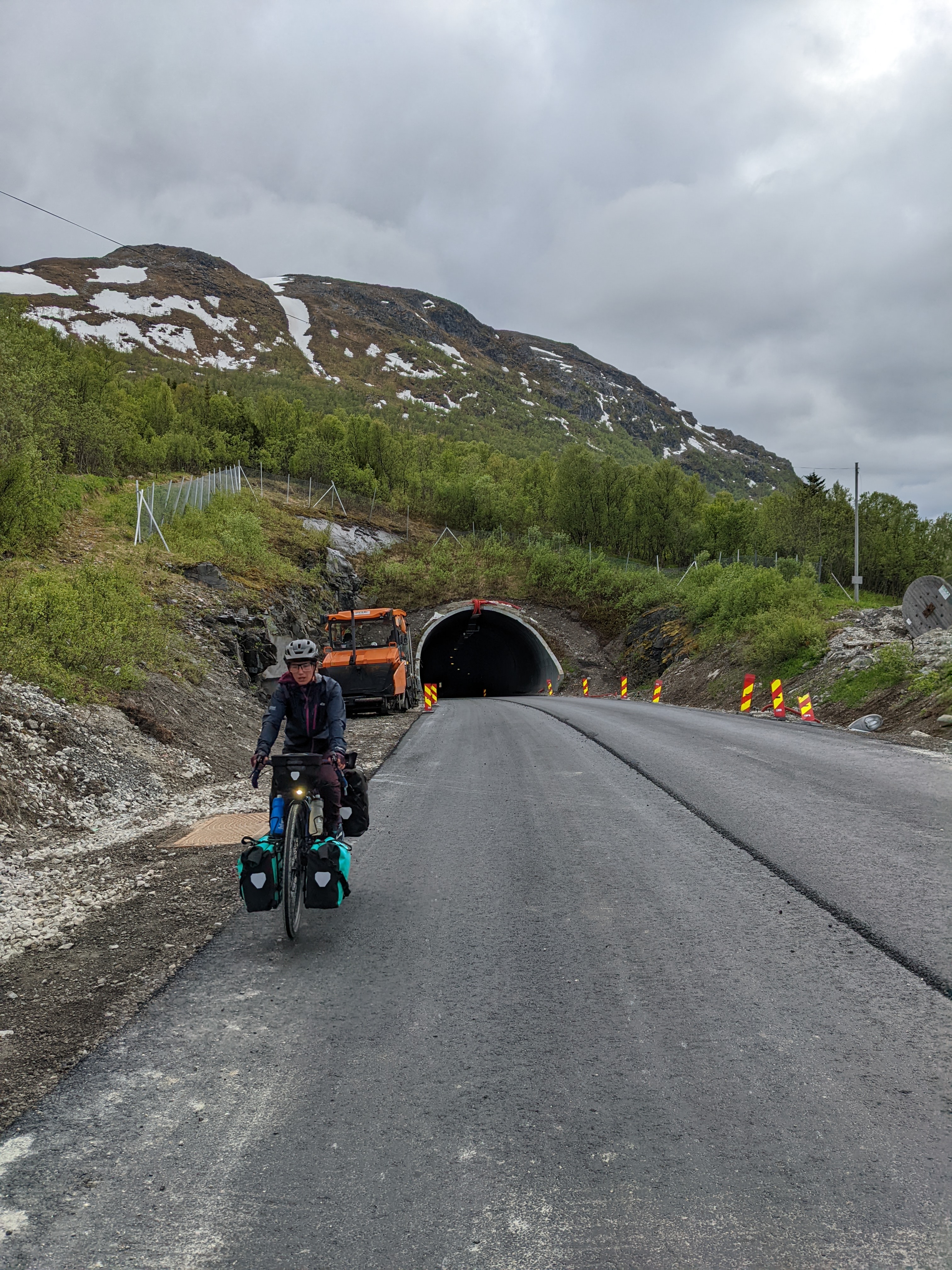
I’ll spare you further description of the tunnel ride - the look on H’s face at the exit tells the story pretty clearly.
To Swampcamp Rotsund
The rest of our ride was brief and lovely. We saw tons of flowers along this road - the first really brilliant blooms of the trip. Some old friends, like these lupins and the sword ferns we saw everywhere, were out in style.
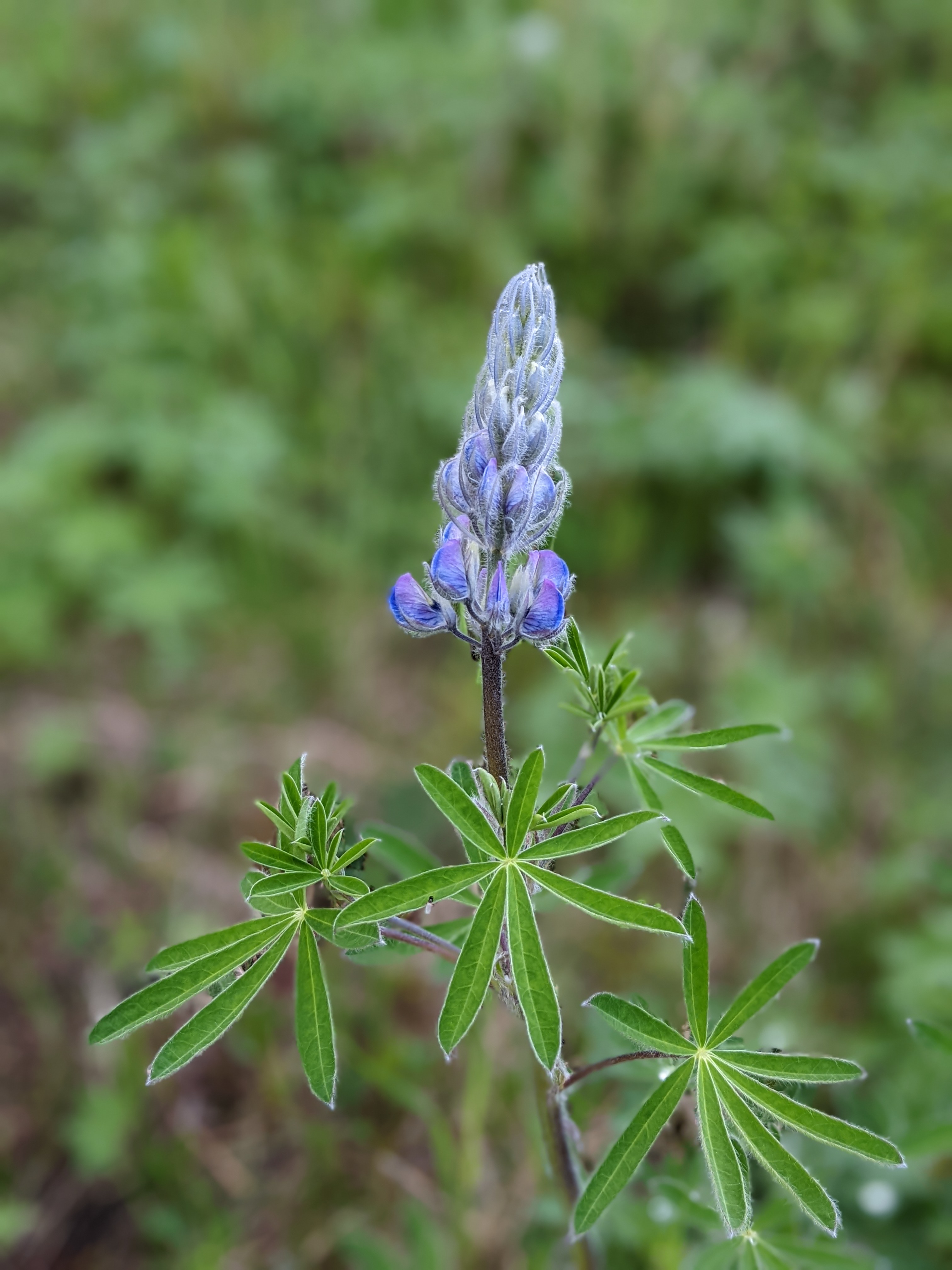
Some new friends were as well. I don’t know what these are, but they’re super cute!
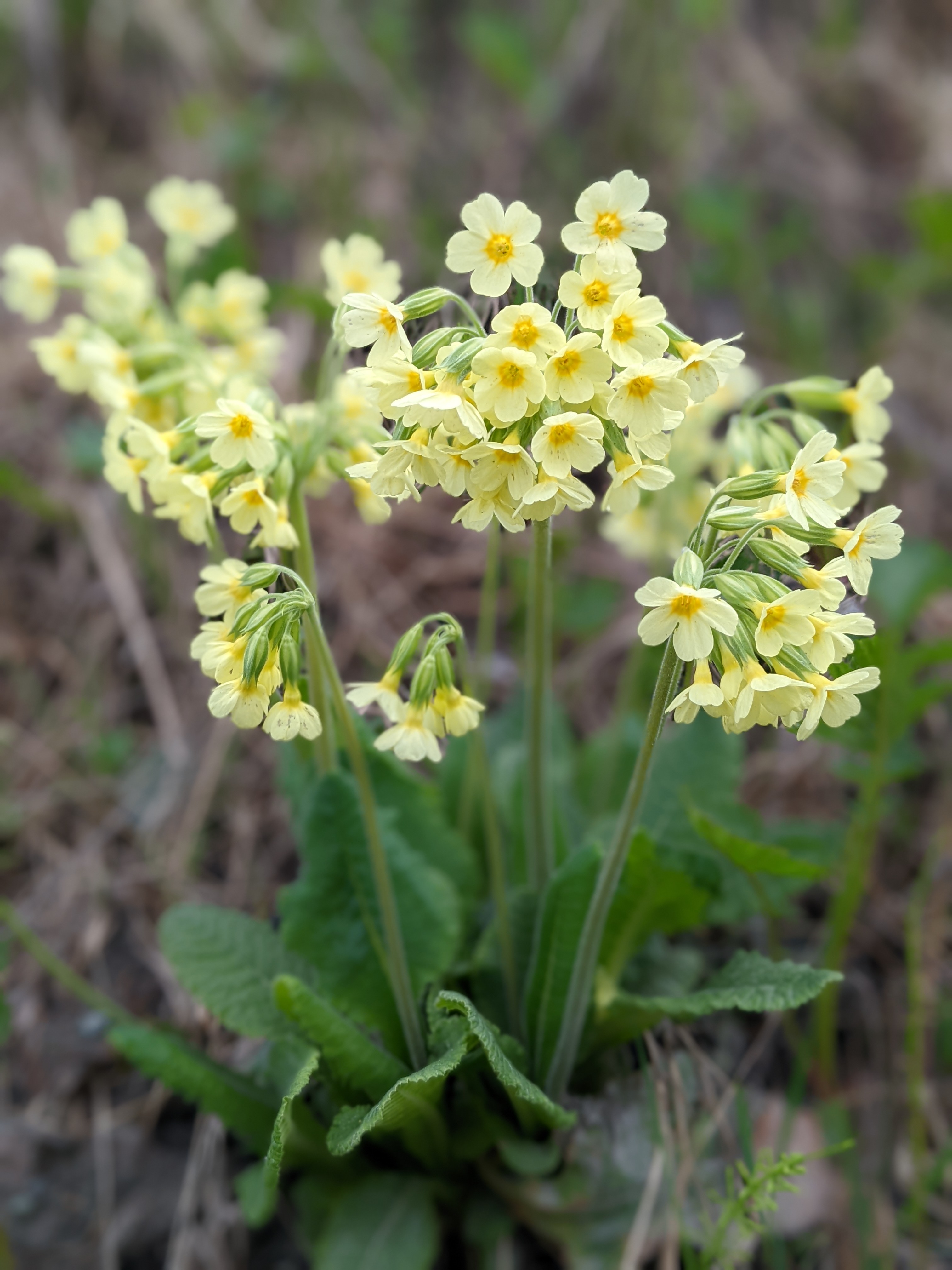
We rode south then west towards Lyngenfjord and the “Lyngen Alps” - a range of high peaks on the fjord’s far side. The foreground peaks were smaller, but a few looked delightfully ski-able, with long, low-angle snow fields (glaciers?) that went for days. The trick, I think, is how to get up there….
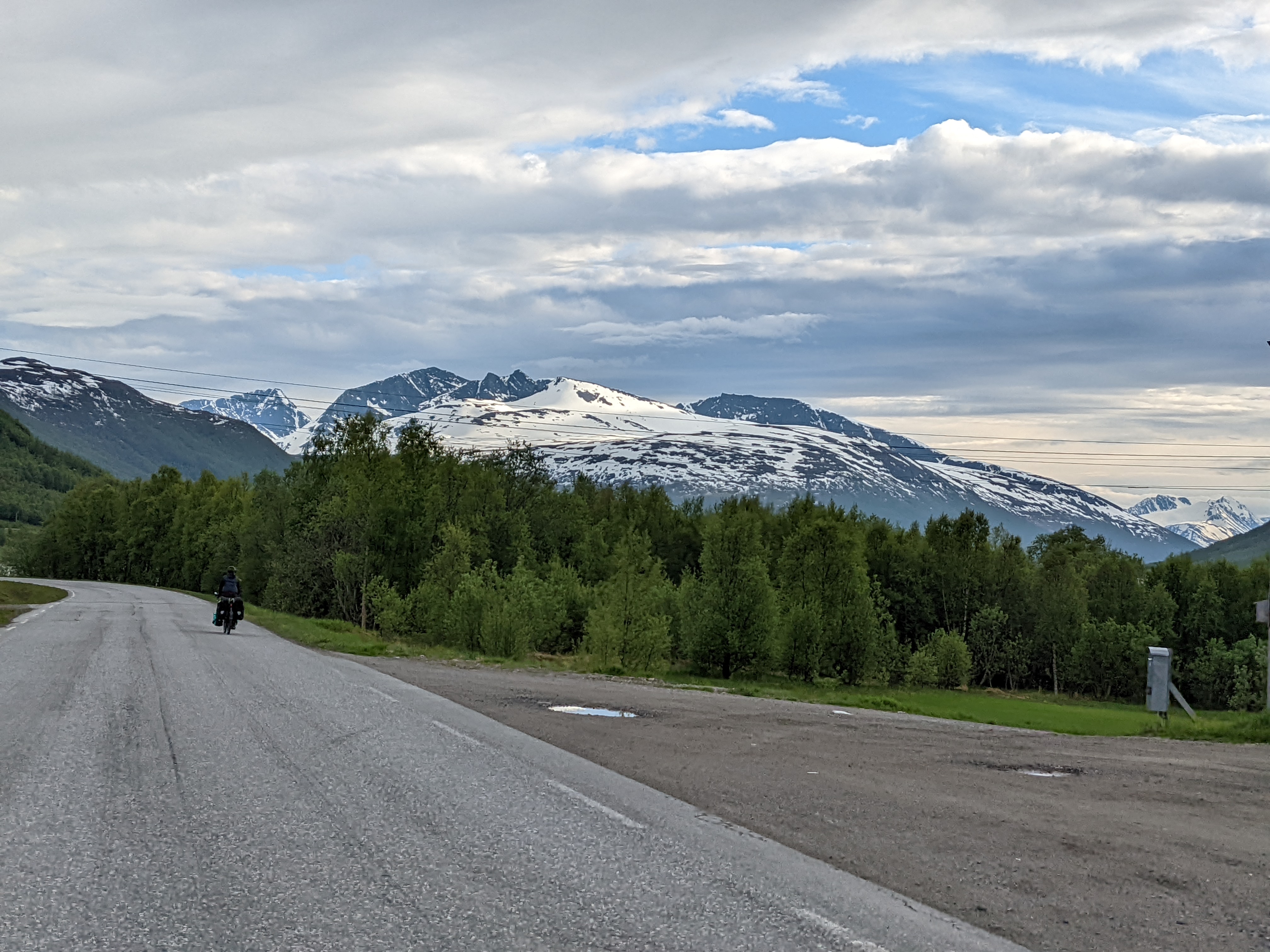
The views were motivating, but it was getting late. After checking out a very weird mushroom remnant we found in a drainage, we decided to call it quits and find a camp site. After a grand total of 25 miles on the bike, it was already 8PM!
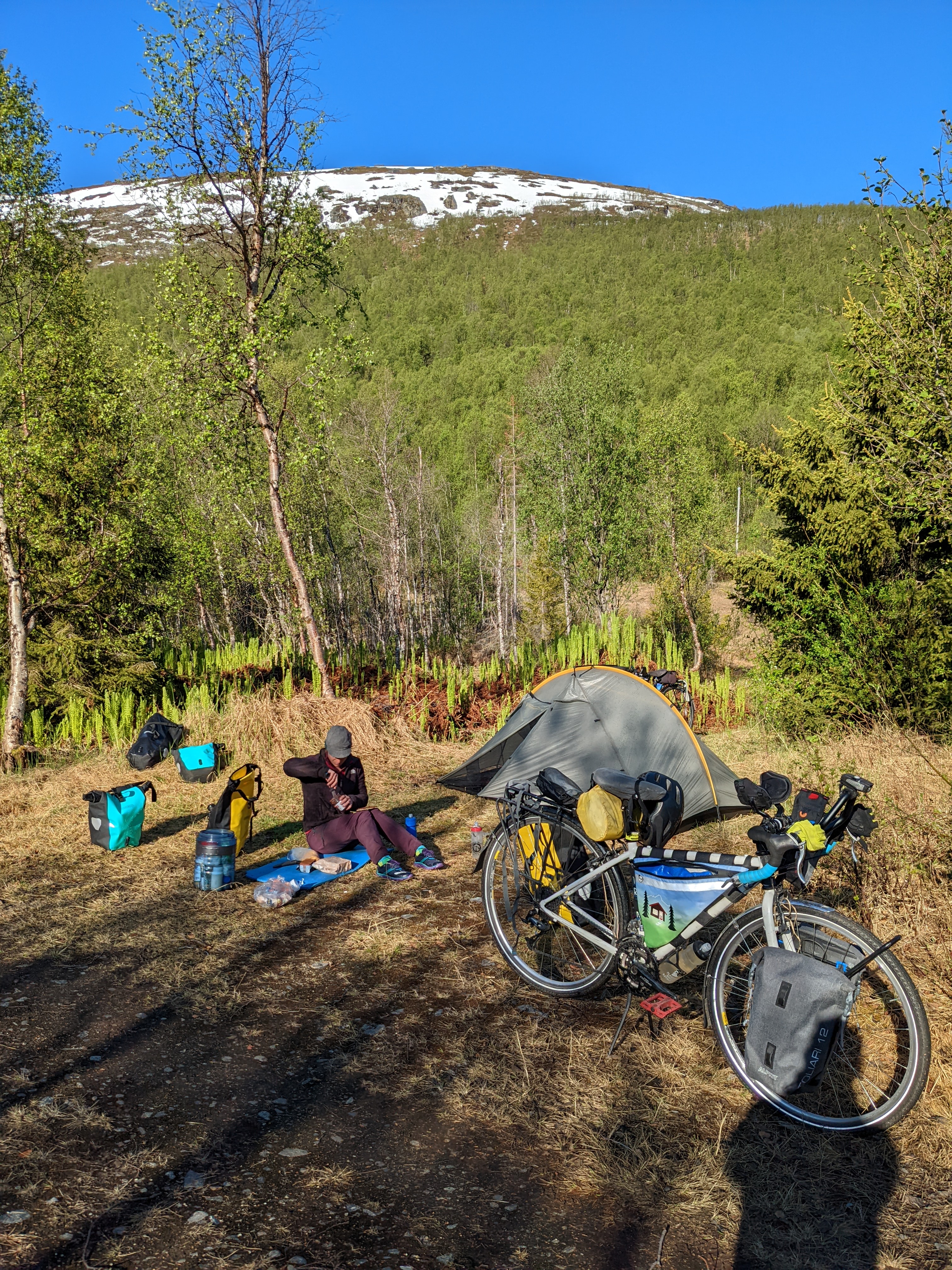
We took the left turn past the sheep farms toward Rotsund, following the loop road out to a spur of gravel that headed up the river valley. Most of the ground was marsh, but we found a nice grassy parking pullout and set up. There may or may not have been a derelict ski jump in the woods above us. Norway is weird sometimes.
Short days breed long days
With our early stop the day before, we woke earlier than usual for the game of ferry hopscotch that would take us to Tromsø by 1900.
- Bike Rotsund to Olderdalen
- Ferry Olderdalen to Lyngseidet
- Bike Lyngseidet to Svensby
- Ferry Svensby to Breidvik
- Bike Breidvik to Tromsø
- Meet Ira after 7
Somehow, we’d given ourselves a third 60-mile day within a week, and a timeline to boot.
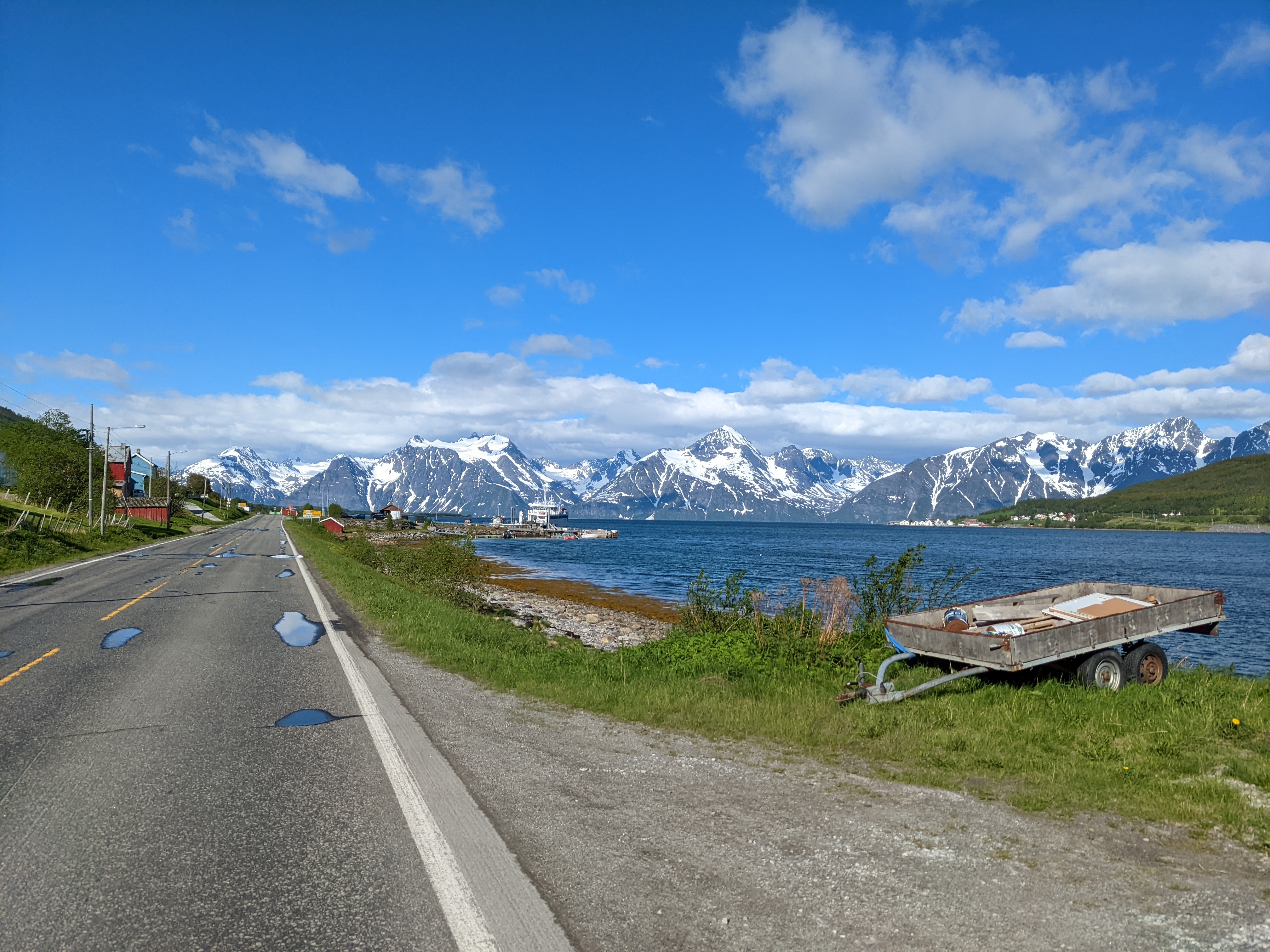
We set out for the ferry terminal in good spirits. The “alps” were gorgeous and the weather was great. We had just enough time to make the boat, though, and H was struggling to keep pace. It had been a wild week of riding, with two of her longest rides ever back to back. Even with that and our wonky sleep schedule on Skervøy, though, something felt funny. It was race pace almost all the way, and we made the boat with only a couple of minutes to spare.
We learned some important lessons on this leg:
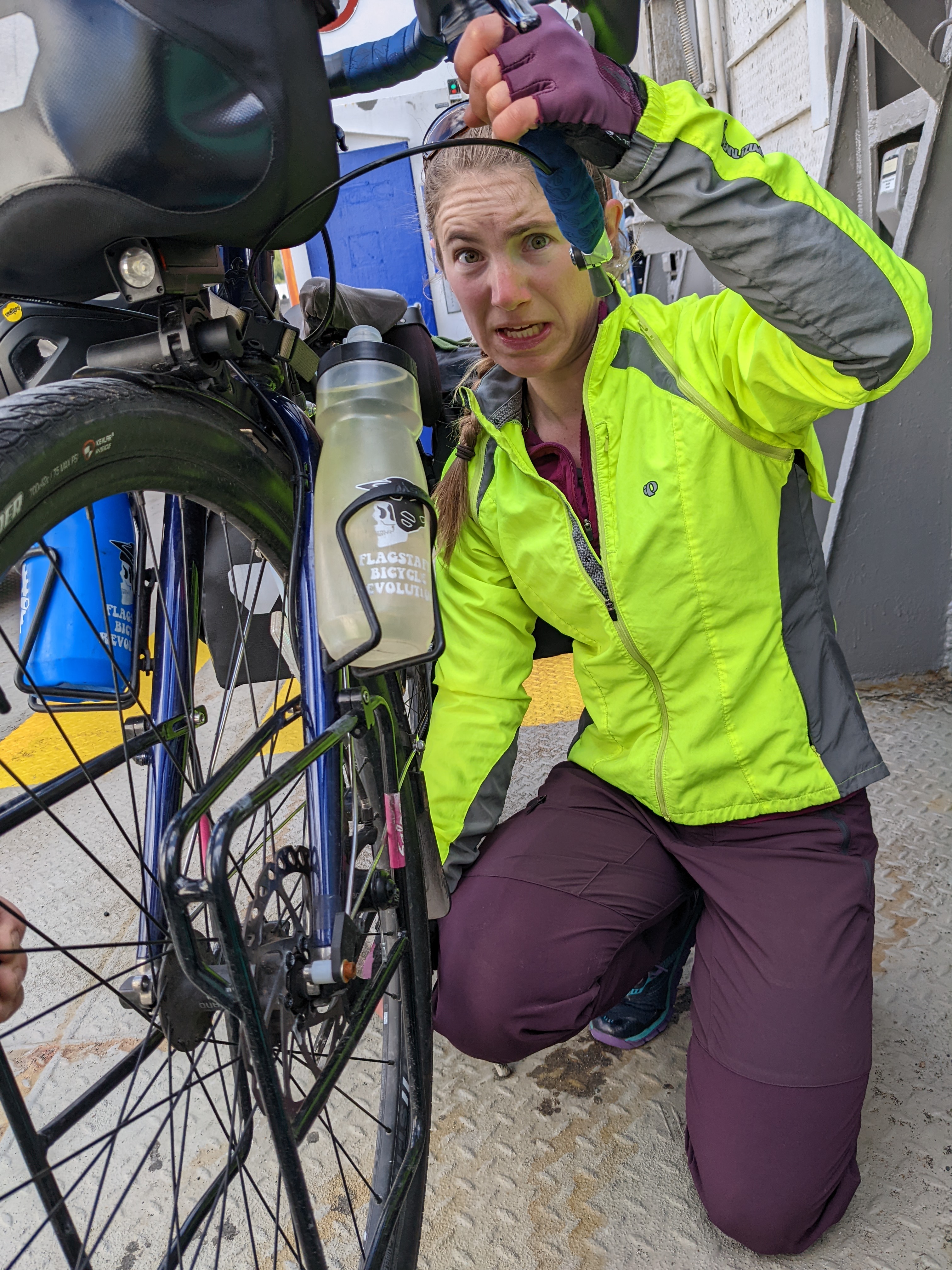 It’s a lot harder to ride fast when your brake rotor is rubbing.
It’s a lot harder to ride fast when your brake rotor is rubbing.
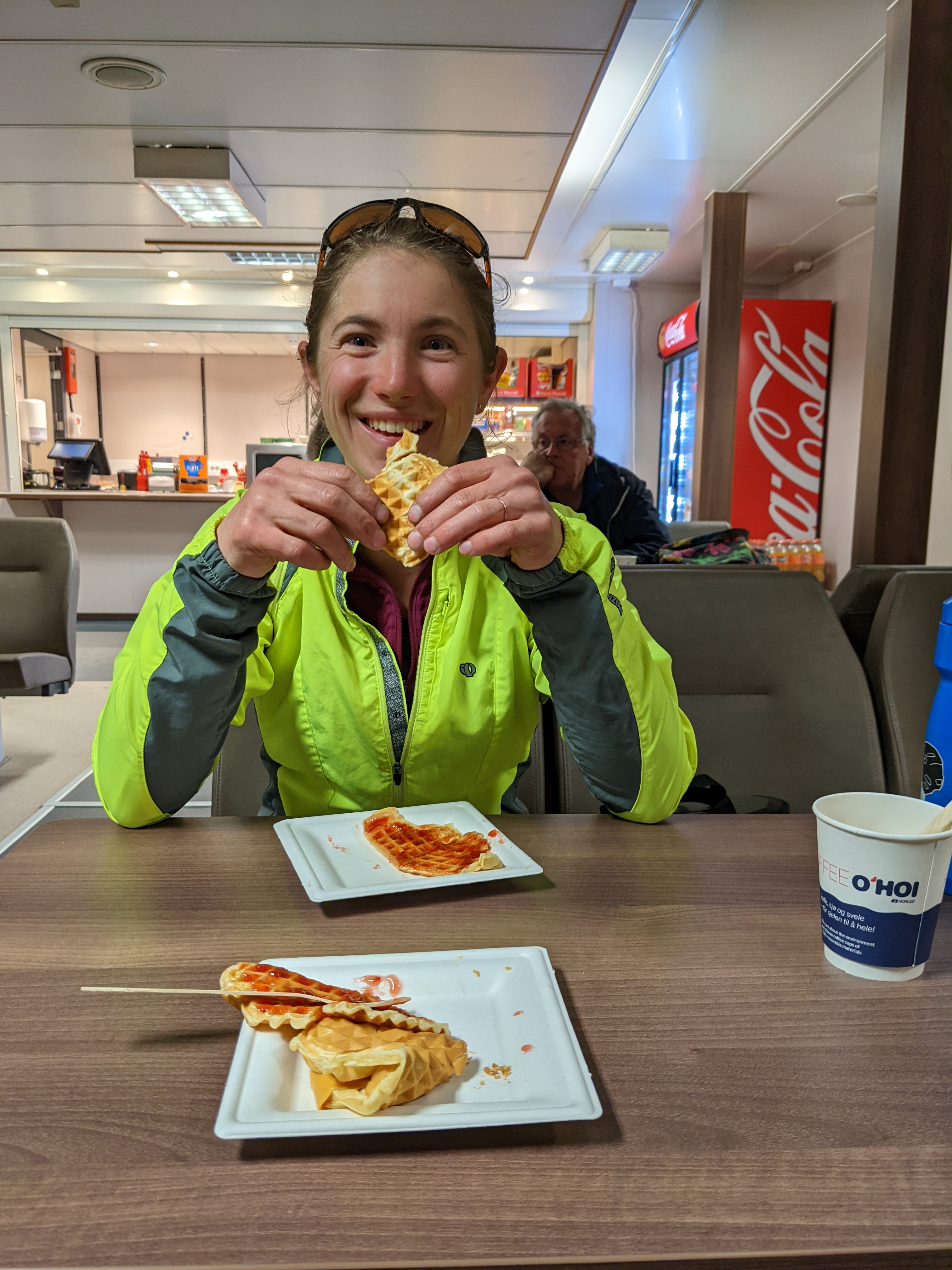 All proper ferries are free for cyclists and serve fresh waffles and coffee.
All proper ferries are free for cyclists and serve fresh waffles and coffee.
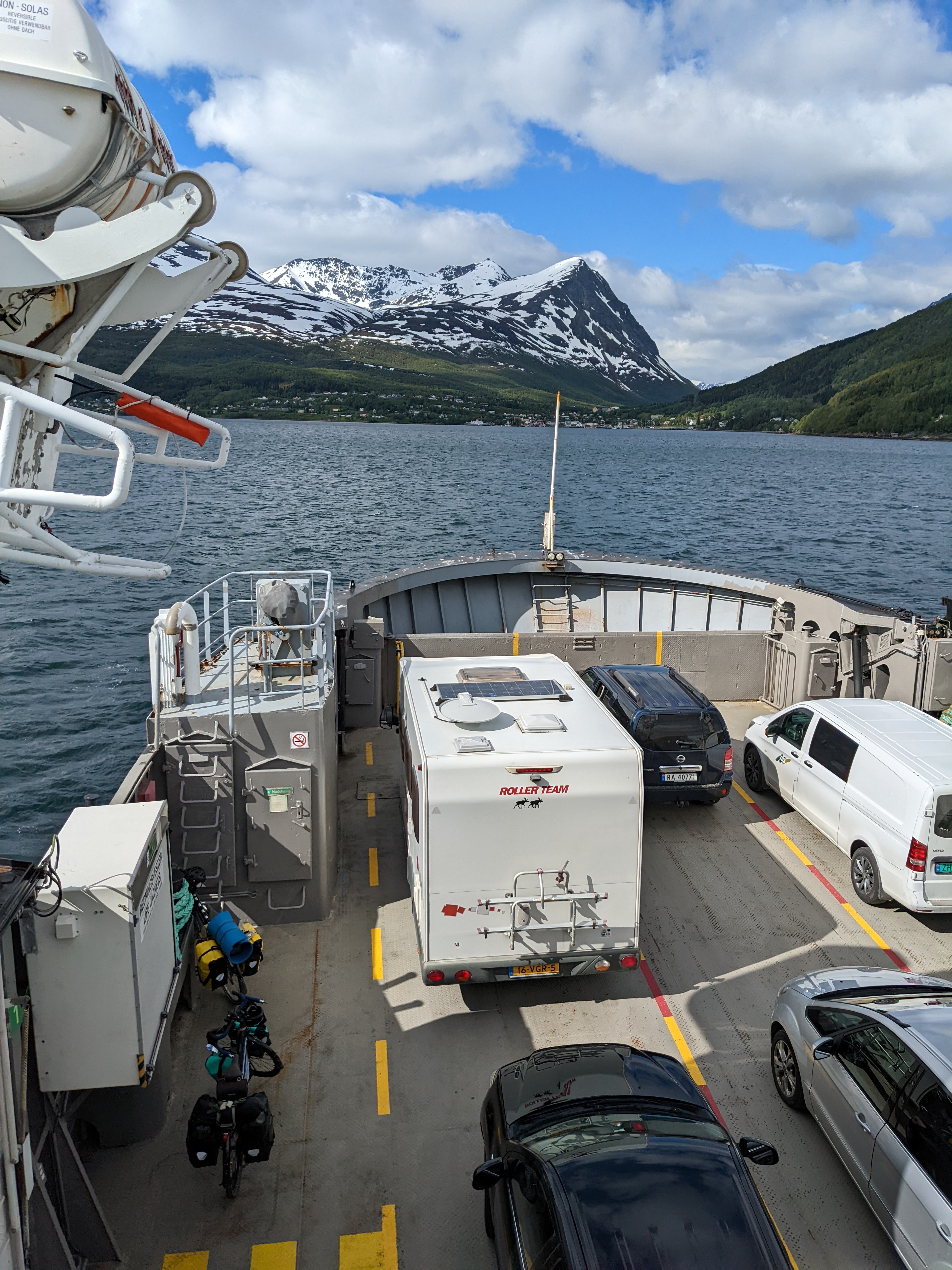 Norway is still pretty from a car ferry.
Norway is still pretty from a car ferry.
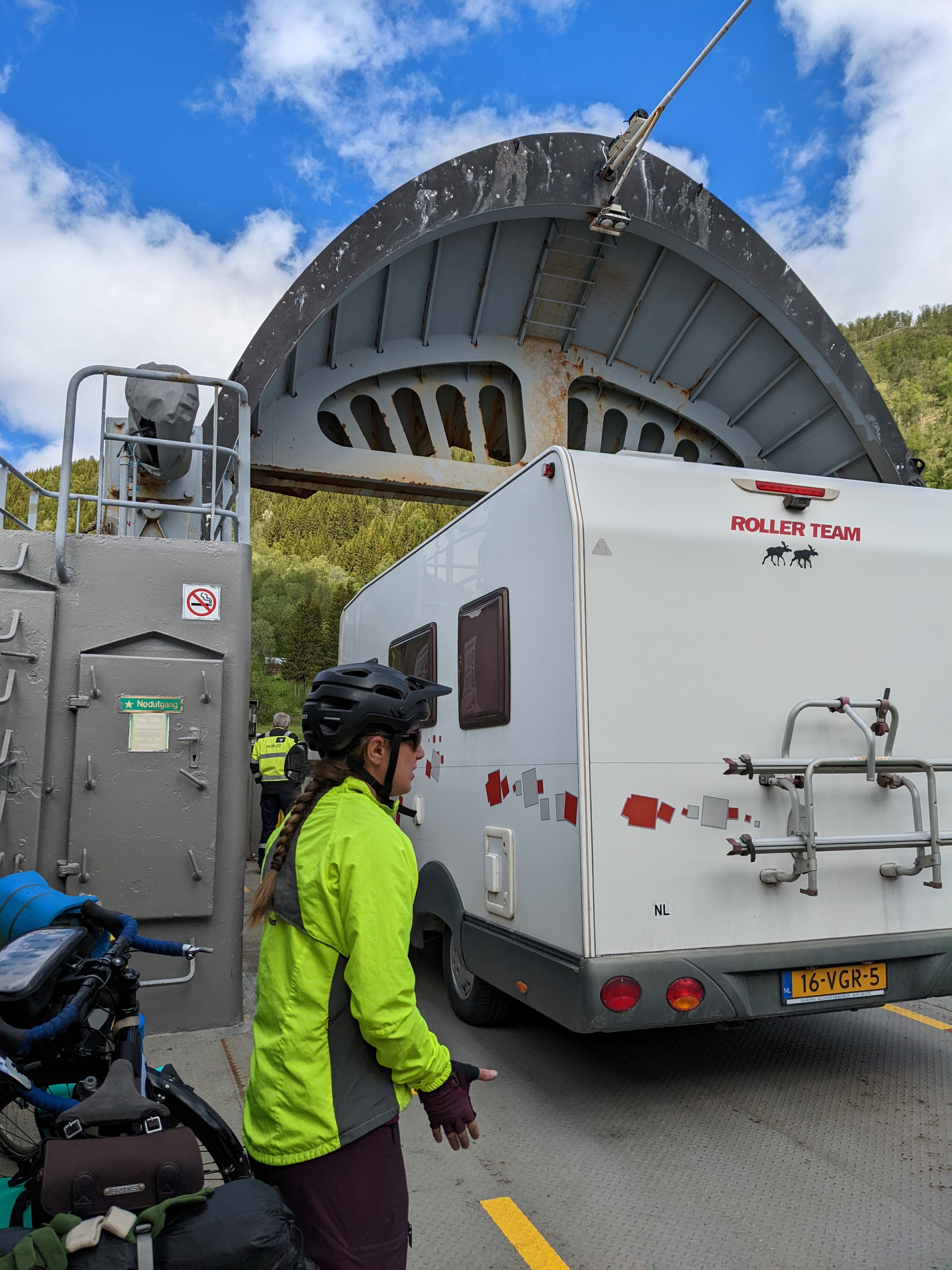 Norwegian ferries are basically big metal sharks that eat cars
Norwegian ferries are basically big metal sharks that eat cars
Bike buddies!
We met our friend Florian again on the first boat. It was great to see him, and we had a good laugh about routefinding. He had had ridden first to the closed bridge from Alta, where he found a guy to take him across on a small boat! Unfortunately, he then had to hike his bike through 5k of snow to get it over some pass.
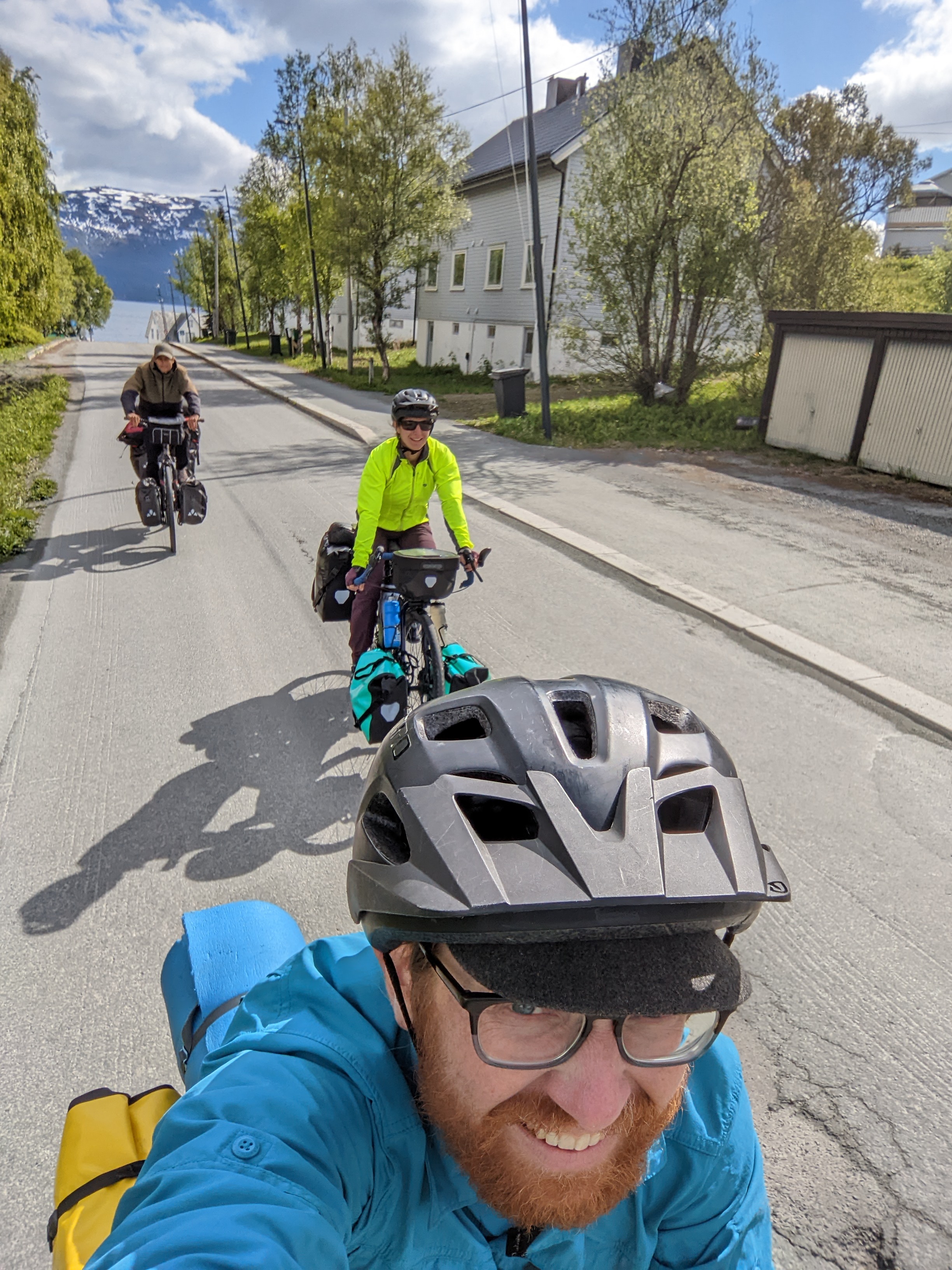
His route to Tromsø was the same as ours, so we had lunch and rode together for the day. The ride from Lyngseidet to Svensby was sunny and glorious, with new signs of life on all sides of the road.
 These guys are soooo pink!
These guys are soooo pink!
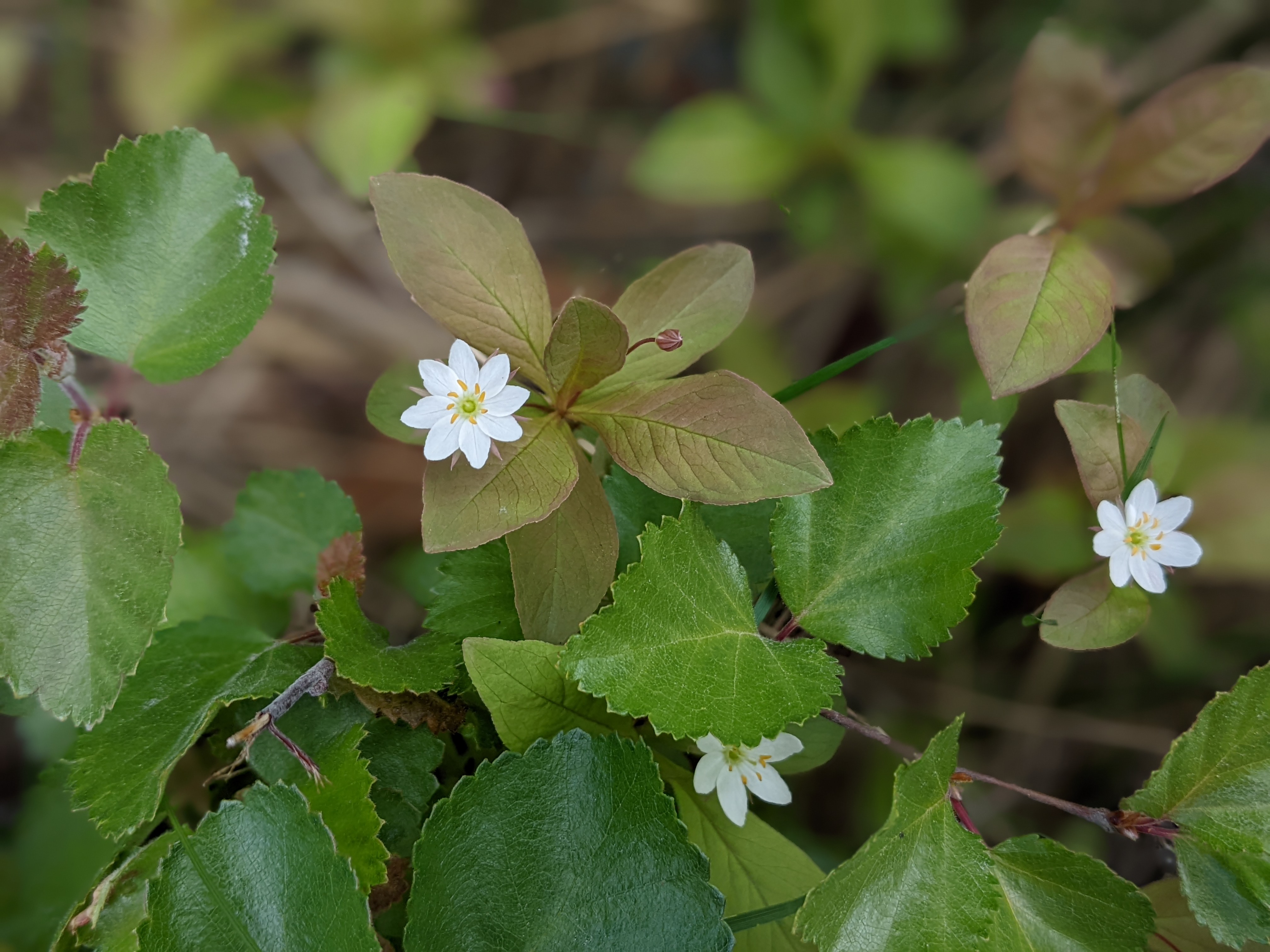 And these guys, though understated, are my favorite for the day.
And these guys, though understated, are my favorite for the day.
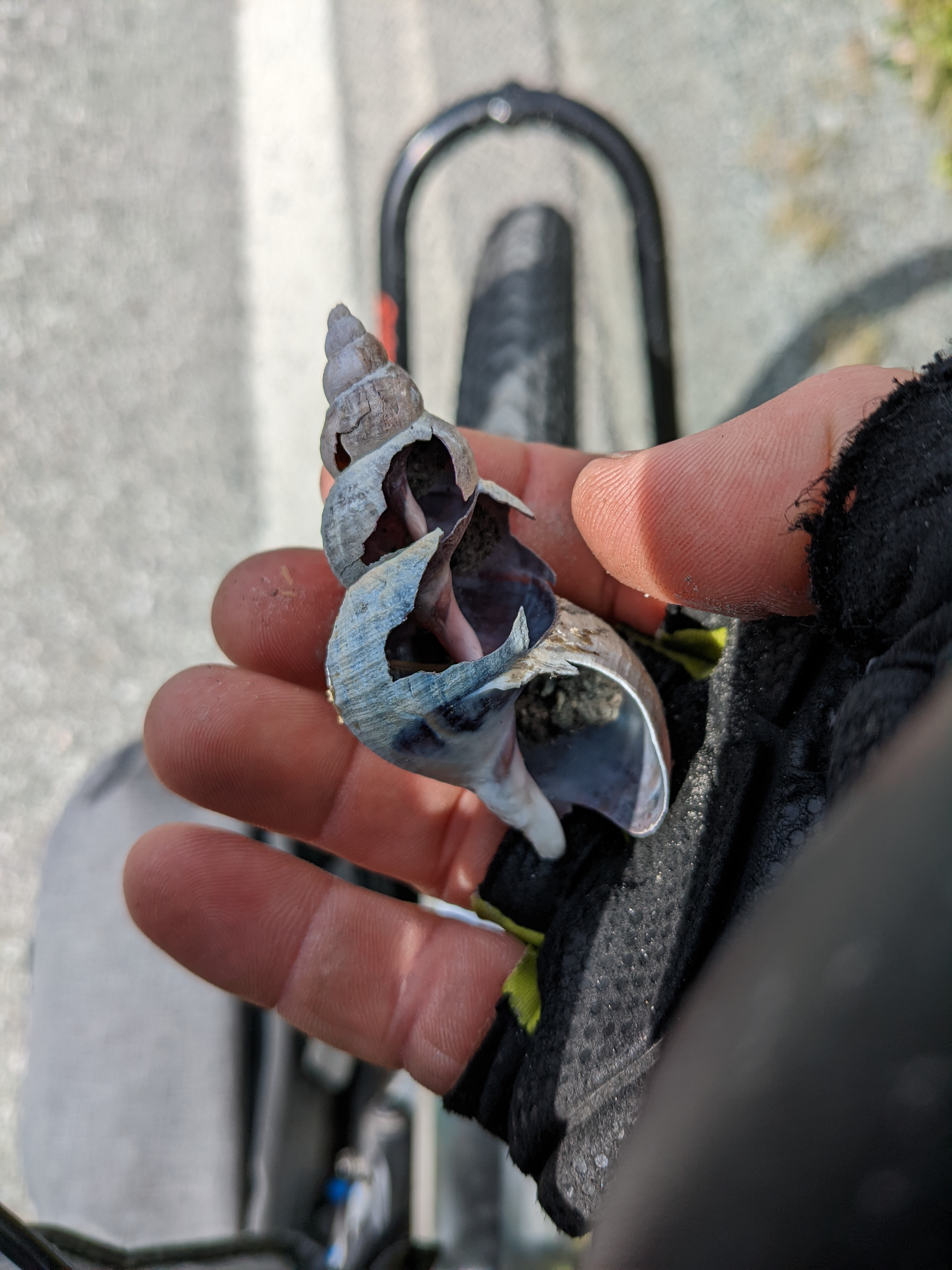 The paucity of nearshore marine life is still still remarkable here,
but a snail shell this big is a good omen that this might be changing as we head west.
The paucity of nearshore marine life is still still remarkable here,
but a snail shell this big is a good omen that this might be changing as we head west.
 And of course, dandelions. Everywhere, suddenly, and lovely in the sunshine.
And of course, dandelions. Everywhere, suddenly, and lovely in the sunshine.
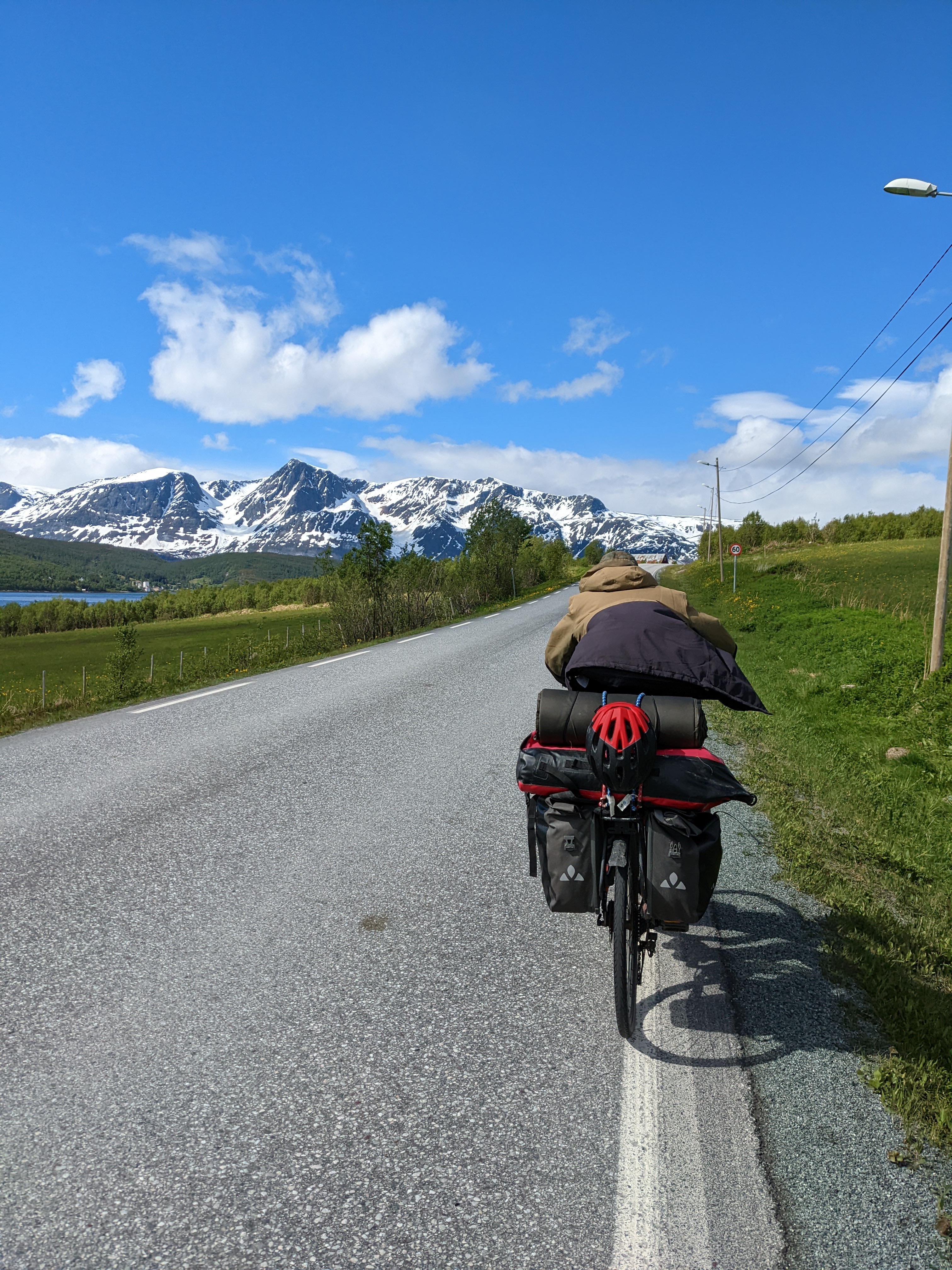
Riding with Florian is fun. His bike is squeaky and makes occasional terrible noises, but he’s easygoing and enthusiastic. It gets him where he’s going, and he’s going far. Little reminders to relax and let the trip take its own shape are good now and then. For these, and for his good company, I’m grateful to him.
Industry and impact
I often try to minimize the visual impact of development in my photos, stepping closer to the roadside, or shooting from below or behind the telephone lines. There is infrastructure everywhere, but even despite this Norway is so beautiful that it’s easy to overlook the impact humans have had on the landscape.

Norway’s scenery can make even a gravel barge look aesthetically pleasing. Norway has the highest per-capita rate of cabin ownership in the world, dotting the coast with quaint little hytter, and lovely run-down fishing sheds.
 This photo, which a roommate tells me is desktop wallpaper-worthy,
is also accidentally a photo of a gravel quarry.
This photo, which a roommate tells me is desktop wallpaper-worthy,
is also accidentally a photo of a gravel quarry.
Like all industrial nations, Norway has grown through resource extraction - fish, game, timber, oil. Despite its wildness, the place feels domesticated in ways that Alaska and Canada do not. There is clean paved road between every small coastal settlement, and the ferries run on time to the smallest communities. There is cell coverage nearly everywhere. The salmon are mostly farmed. There are few bears and few wolves, and the reindeer that dot every mountain in the north are not caribou because they are not wild.
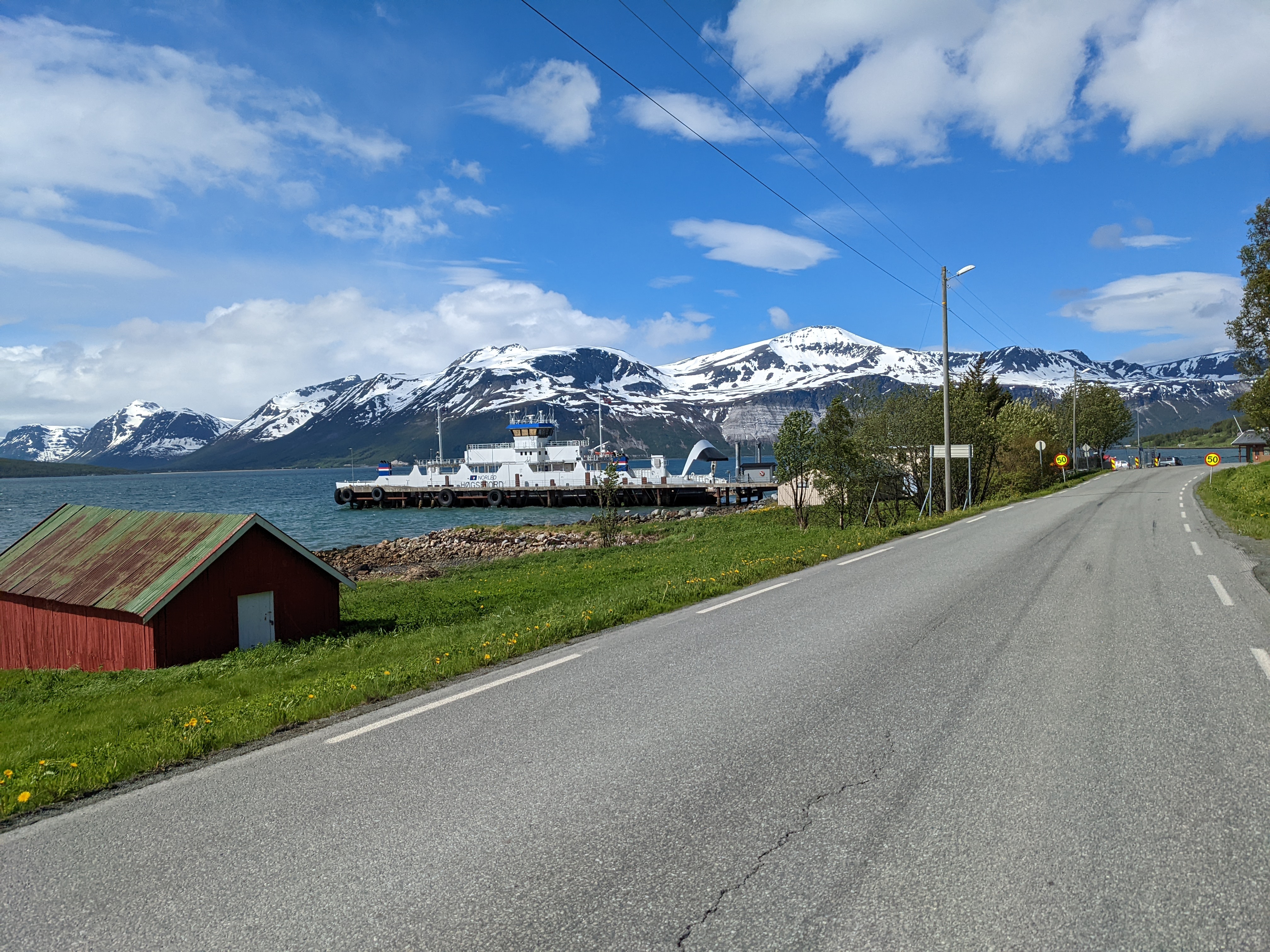
And if this sounds damning, it is and it isn’t. The reindeer are owned and tagged, but their impact on the landscape is visibly lighter than that of the cows or sheep we see occasionally. Most of Norway’s forests are working timber forests, but we’ve seen few if any clear cuts here in the North. The landscape is itself, in some important ways, domesticated, but the visible impact on it often seems lighter than an American counterpart might.
To Tromsø
The ride across the peninsula and up to Tromsøy was a bit rugged, so photos are in short supply. The moment we stepped off the boat in Breidvik, we realized we’d sailed out of the good weather. Clouds had started building, grey, and the wind blew hard and cold enough that we hid in the lee of a public toilet for shelter when we ate our lunch.
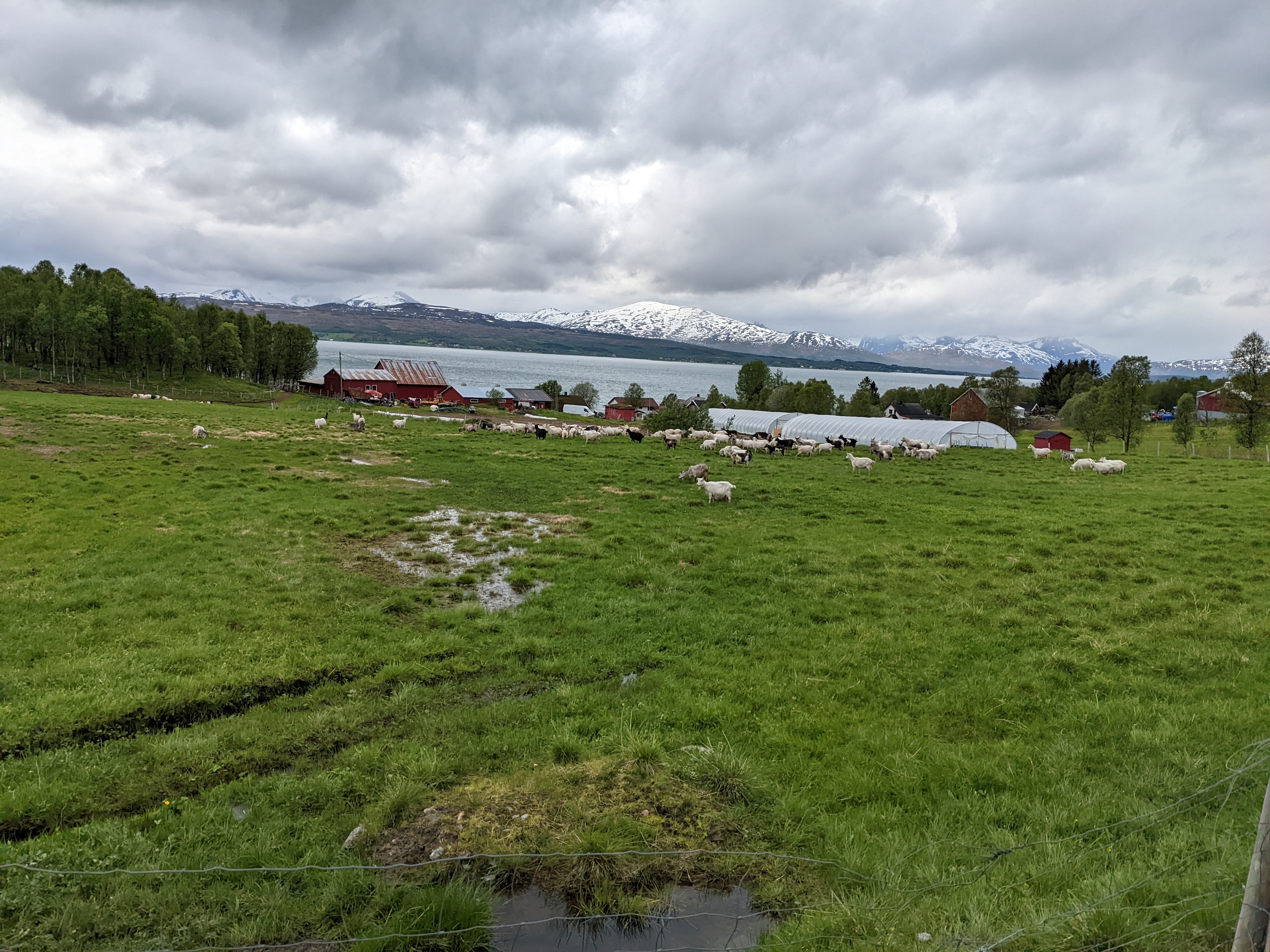
As we descended the pass to the west side of the peninsula, we rode through a bad squall. Hard rain and wind had me scrambling for my foul-weather gear. Once my waterproof (på norsk “vanntett”) layers were on, I realized I couldn’t fit anything inside the kitchen gloves I brought from home and my rain pants were pretty leaky. If we’re going to get more rain like this, and in two months I’m sure we will, I’ll need gloves and pants that work.
The E8 highway to Tromsø is very busy, and not much fun to ride. Once the cycle way begins, though, there are lovely farms and neighborhoods all the way to town. We met a young Ukrainian refugee out walking her family’s dog, and pedaled through light rain until we’d crossed the bridge onto Tromsøy.

We parted ways with Florian, and on a reccomendation from our Warm showers host we stopped for Eritrean/Ethiopean food at Wedeb’s. Very mild, but possibly the best meal of its kind that I’ve had. Then up a massively steep hill to our home for the next few days.
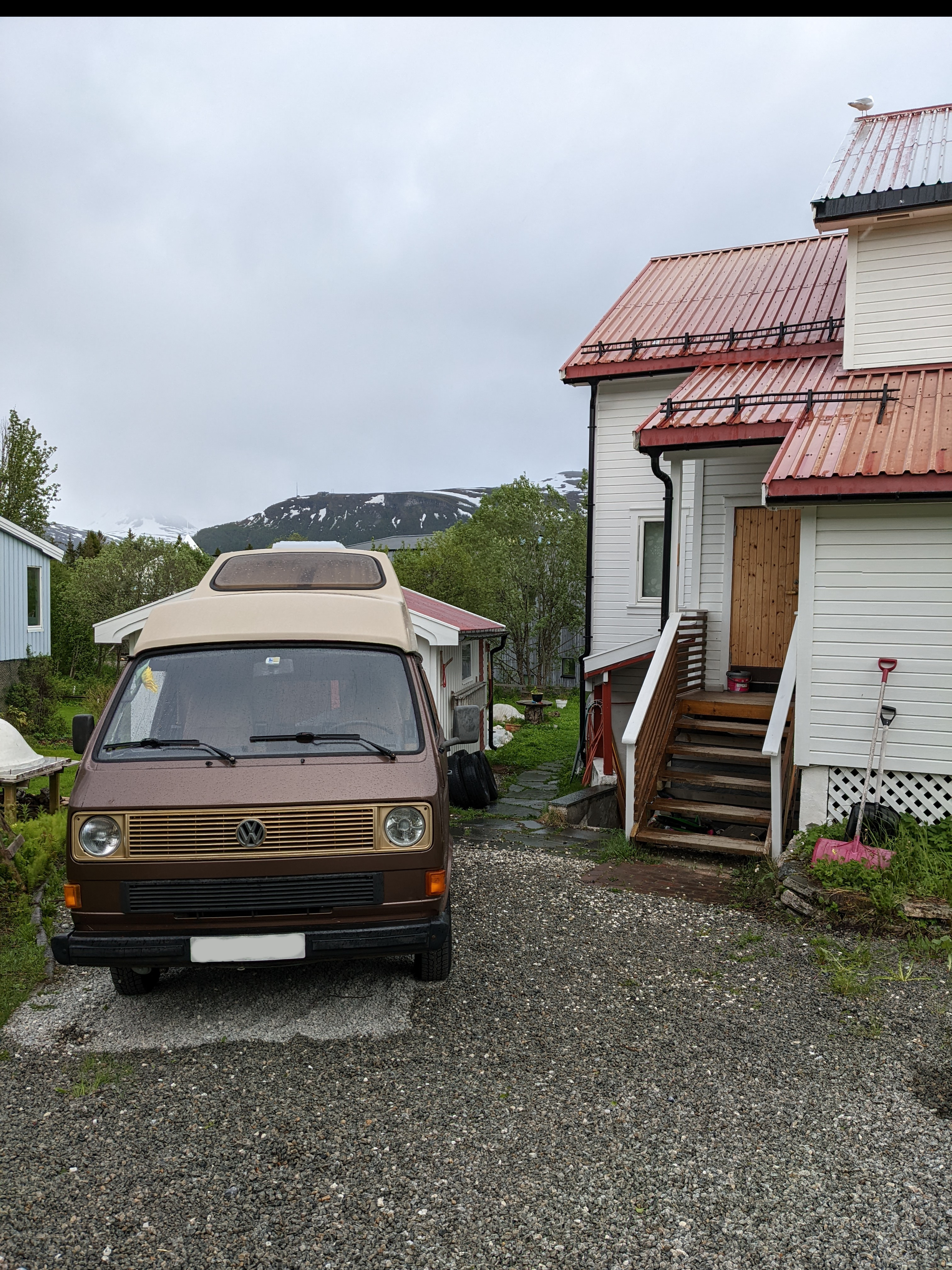
New friends
- RODENTIA! Finally! Maybe a lemming? Or maybe I just really want to see a lemming.
- Lots of flowers
- Super weird mushroom guy. Crazy fat-stalked stalked puffball? Gastroid bolete? Weird.

